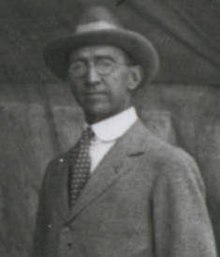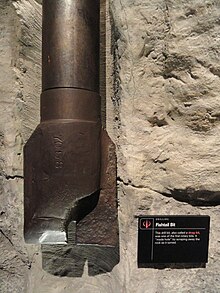Howard R. Hughes Sr.
Howard R. Hughes, Sr. | |
|---|---|
 Hughes Sr. in 1917 | |
| Born | Howard Robard Hughes September 9, 1869 Lancaster, Missouri, U.S. |
| Died | January 14, 1924 (aged 54) Houston, Texas, U.S. |
| Burial place | Glenwood Cemetery (Houston, Texas) 29°45′56″N 95°23′07″W / 29.7656°N 95.3852°W |
| Education | Missouri Military Academy |
| Alma mater |
|
| Occupation(s) | Founder of Hughes Tool Company, businessman |
| Spouse |
Allene Stone Gano
(m. 1904; died 1922) |
| Children | Howard Robard Hughes Jr. (son) |
| Relatives | Rupert Hughes (brother) |
Howard Robard Hughes Sr. (September 9, 1869 – January 14, 1924) was an American businessman and inventor who founded the
Early life and education
Howard Robard Hughes Sr. was born on September 9, 1869, in



After spending his childhood and early adulthood in Keokuk, Iowa, he lived in various places such as New York City, where he was a member of the Harvard Club, Denver, Joplin, Missouri, and Beaumont, Texas prior to finally settling in Houston, where his son Howard Jr. was born.[2]
Hughes Sr. was educated at Missouri Military Academy, in Mexico, Missouri.[3] He then entered Harvard University in 1893, dropping out the next year.[4][5]
After leaving Harvard in '94, I found myself in the Law School of the Iowa State University. It was my father's wish that I succeed him in his practice. Too impatient to await the course of graduation, I passed the examination before the Supreme Court of Iowa and began the practice of law. I soon found the law a too-exacting mistress for a man of my talent, and I quit her between dark and dawn, and have never since been back. I decided to search for my fortune under the surface of the earth.
— Howard Hughes Sr., 1912[4]

Career
Hughes Sr. married Allene Stone Gano, on June 24, 1904, in Dallas County, Texas, and engaged in various mining business endeavors before capitalizing on the Spindletop oil discovery in Texas, as a result of which he began devoting his full-time to the oil business. In 1906, Hughes began experiments of ways to replace the state of the art technology at that time, the fishtail bit. (See image)
In 1908, he and Walter Benona Sharp, his business partner, built a two-cone drill bit model using wood.[6] On November 20, 1908, he filed the basic patents for the Sharp-Hughes Rock Bit, and on August 10, 1909, was granted U.S. patent 930,758 and U.S. patent 930,759 for this rock drill. Hughes's two-cone rotary drill bit, nicknamed "rock eater", penetrated medium and hard rock with ten times the speed of any former bit, and its development revolutionized oil well drilling.[4]
It is unlikely that he actually invented the two-cone roller bit, but his legal experience helped him in understanding that its patents were important for capitalizing on the invention. According to the PBS show History Detectives, several other people and companies had produced similar drill bits years earlier. In its initial tests at Goose Creek Oilfield in 1909 where the first offshore drilling for oil in Texas was occurring in Harris County, 21 mi (34 km) southeast of Houston on Galveston Bay, the Sharp-Hughes Rock Bit penetrated in 11 hours 14 ft (4.3 m) of hard rock which no previous equipment had been able to penetrate at all.
During WW l, he invented a tunnel boring machine for soldiers to create tunnels from their trenches.[6]
He co-founded the
Awards and Accolades
100 years after the Hughes drill bit had been patented, the American Society of Mechanical Engineers (ASME) designated the technology a Historic Mechanical Engineering Landmark on August 10, 2009.[6]
Death and legacy


On January 14, 1924, Hughes Sr. died of a heart attack caused by an embolism at his company's offices on the fifth floor of the Humble Oil Building in Houston at the age of 54.[8] After his death, his only child, Howard Jr., assumed control of the company as its 75% owner at the age of 19. In his will, Hughes Sr. had left the remaining 25% to his parents, Felix Sr. and Mimi, and his brother Felix Jr.[8] A little more than a year after his father's death, Hughes Jr. had himself declared an adult (the age of majority at the time being 21) and bought out his grandparents and uncle for full control of Hughes Tool Company. The next year in 1925, Hughes Jr. appointed Noah Dietrich as CEO of Hughes Tool while he himself left for California to pursue filmmaking and aviation.[8]
In 1933, Hughes Tool engineers created a
Awards and achievements
The "Sharp–Hughes" patent rotary rock drill bit was designated a
See also
References
- ^ a b Saerchinger, César (1918). International Who's who in Music and Musical Gazetteer. Current Literature Publishing Co. p. 293.
- ^ Harvard College Class of 1897, Second Report. Cambridge, Massachusetts: University Press. 1903. p. 97.
- ^ Missouri Military Academy Alumni Directory, 2009. Mexico, Missouri: Missouri Military Academy. p. 82 – via Harris Connect.
- ^ a b c d Harvard College Class of 1897, Fourth Report. Boston: Rockwell & Churchill Press. 1912. pp. 218–220.
- ^ Donald L. Barlett, James B. Steele. Howard Hughes: His Life and Madness. New York: W. W. Norton & Company, 2004.
- ^ a b c "Hughes Two-Cone Drill Bit: Designated a Historic Mechanical Engineering Landmark by The American Society of Mechanical Engineers (ASME)" (PDF).
- ^ "1952 Purchase of Hughes House". alumni.stthom.edu. Retrieved April 21, 2018.
- ^ ISBN 978-1-59777-549-6.
- ^ Texas Monthly: Read Me. Texas, Texas Monthly
- ^ "Hughes Two-Cone Drill Bit: Designated a Historic Mechanical Engineering Landmark by The American Society of Mechanical Engineers" (PDF). The Woodlands, Texas: Baker Hughes. Aug 10, 2009. Retrieved Feb 21, 2016 – via Mechanical Engineering Magazine.
